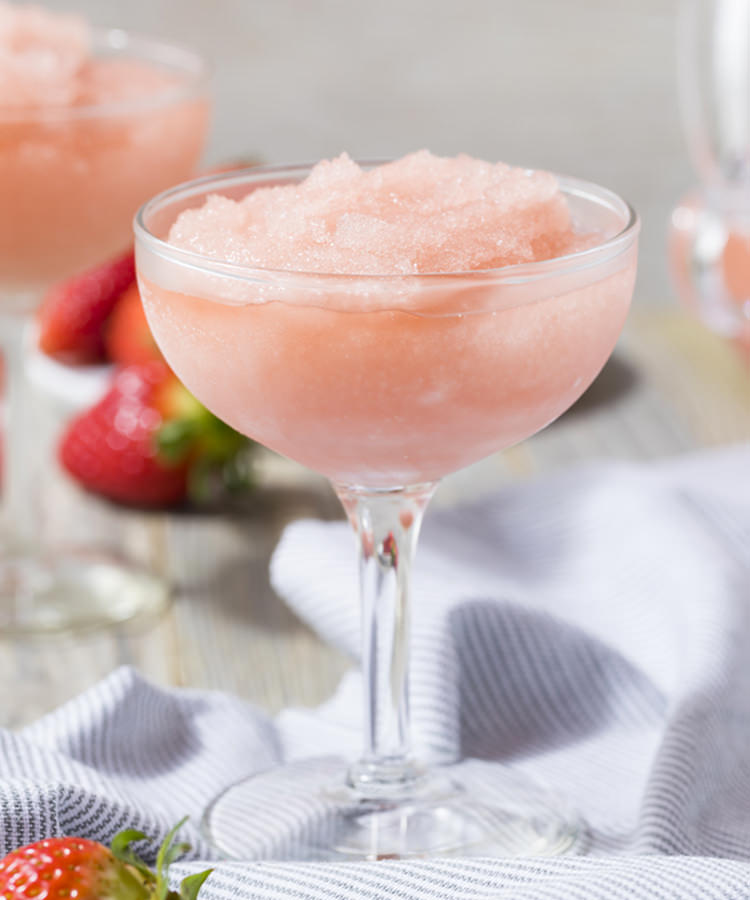When it comes to booze, I’ll try anything once, and most things twice. It was this that led me, however late to the game, to recently try my first “frosé.” Frosé, if you’ve been living under a rock, is the highly lauded slushy version of your favorite summer wine that exploded last summer. With memories of last year’s enthusiasm for the beverage, plus the aforementioned principle, I set out to try my first frozen wine beverage.
But reader, I was sorely disappointed! I tried a second, and a third, and a fourth frosé in hopes that the drink that defined 2016 could do double duty this summer. But I have to confess that after drinking four different frosés, I have come to the conclusion that this pink slushy should have been abandoned in the test kitchen where it hatched.
I’m going to explain this no doubt incredibly unpopular point of view. But first, a disclaimer: I’m not a wine snob. The opposite, in fact; I’m that writer who aged Two Buck Chuck to see what would happen. I spent last summer ranking and recreating bottled wine coolers. I have experimented (purely for professional purposes) with cannabis-infused wines. I’ve even (gasp!) praised White Zinfandel. I’m always up for edible adventure. But frosé is one of the few things I’ll never choke down again.
Here’s my argument: Frosé is a waste of time (and blenders) because freezing wine ruins a perfectly good beverage, and there are already plenty of frozen options for beating sultry summer temperatures. Freezing wine destroys the structure of the drink by separating the chemical compounds that make wine’s flavors and aromatics so complex and delicious. As a result, you have to pile on the extra (often sugary and questionably made) ingredients to create a barely palatable drink.
Frosé, an odd combination of lemony tart and sickly sweet, is barely reminiscent of wine and then only in color. Usually, it’s a combination of rosé, lemon juice, sugar or fruit, and occasionally an additional spirit like vodka. The problem with frosé is that it takes away the best parts of rosé wine — ripe fruit flavors, floral aromatics, a crisp refreshing finish — and attempts to salvage it with sweeteners, lemon juice, and fruit.
Wine is a delicate product, and extreme temperatures ruin it the same way they ruin lettuce. High temperatures cook the wine, and freezing wine separates its components, essentially ripping apart the wine’s flavor and aroma compounds. Alcohol lowers the freezing point of water, which is why that vodka in the freezer never becomes a solid block. Because wine has a lower alcohol content than spirits, it still freezes in a standard kitchen freezer. That freezing causes irreparable damage to the flavor compounds, so even when thawed, the wine doesn’t bounce back.
Exposed wine (like the wine ice cubes in many frosé recipes, or half-full bottles) also oxidizes in the freezer because the wine is exposed to air as it freezes, making what taste remains bitter instead of fruity. This is why bottles forgotten in the freezer and wine ice never taste just right, and the best attempts at frosé don’t taste wonderful. Taste is subjective, but the science behind freezing alcohol is not. Wine simply isn’t designed to be frozen, and its flavors are marred by the process.
But there’s another reason frosé is an abomination (I said it; come at me, Twitter). It’s because the aroma and flavor of wine are most visible, and best appreciated, between 55 and 65 degrees, far warmer than your average refrigerator or slushy machine. Winemakers spend most of a year designing and tweaking their wines to shine at this temperature, so serving rosé frosty is a waste from a winemaker’s perspective. So not only does frosé break down a wine’s best components, but it masks whatever flavor remains with its frosty serving temperature in a true lose-lose situation.
If you want a frozen drink, there’s an entire genre for that, and a delicious one, too. The difference between frosé and blended cocktails is simple and explains why the latter have been a summer staple for so long: The alcohol doesn’t freeze, which keeps the flavors of the spirit intact. Most frozen cocktails rely on fruit, juices, and sweet mixes (like bottled Margarita mix or the homemade version) to freeze and give the drinks their signature slushy consistency. With traditional frozen cocktails, you can have the frostiness, the flavor, and the Insta-worthy glassware, too.
Look, at the end of the day, drink what you like. But also drink what makes sense. Ruining a beautiful product and hiding that sin under lemon juice and strawberries just doesn’t make sense. So forget frosé. Sip your wine as is, and give blended cocktails their summer spotlight back. Strawberry Daiquiris look better on Instagram, anyway.
